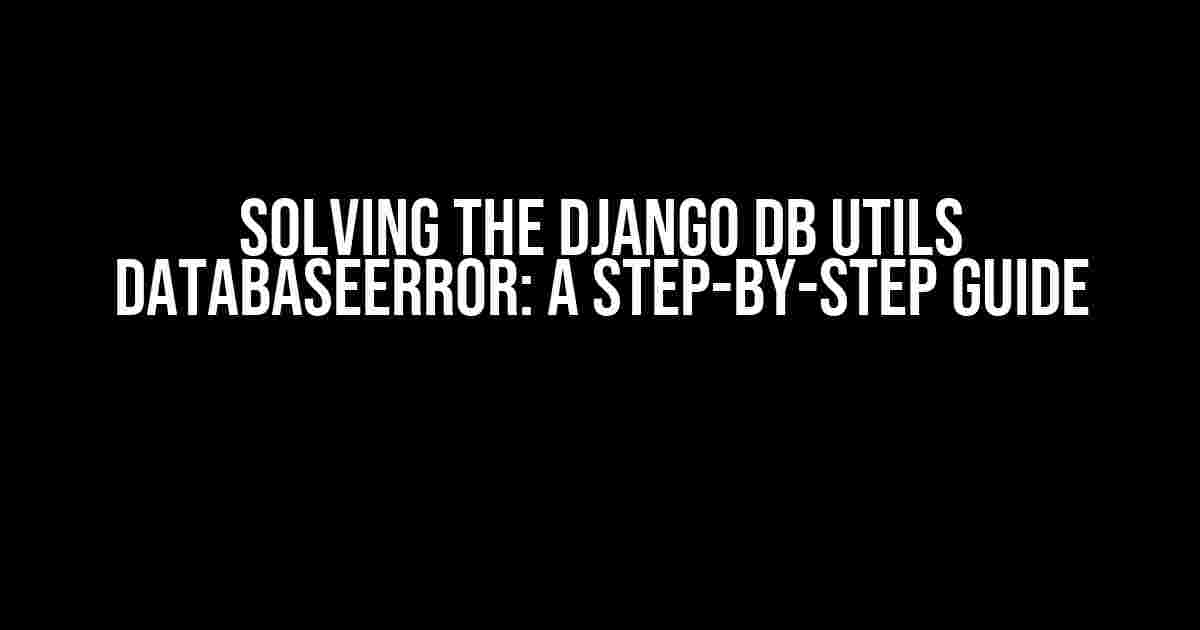Are you tired of encountering the dreaded “django.db.utils.DatabaseError: DPY-4027: no configuration directory to search for tnsnames.ora” error in your Dockerized Django application? Well, you’re in luck because we’re about to dive into the world of Oracle database configurations and get your application up and running in no time!
What is the error about?
The error “django.db.utils.DatabaseError: DPY-4027: no configuration directory to search for tnsnames.ora” occurs when your Django application, running in a Docker container, fails to connect to an Oracle database. This error is usually associated with the `cx_Oracle` library, which is used to connect to Oracle databases in Python.
The importance of tnsnames.ora
The `tnsnames.ora` file is a crucial configuration file in Oracle databases that maps a TNS connection string to a network address. It’s essentially a lookup table that helps your application find the correct database server. Without it, your application won’t be able to connect to the database, resulting in the error we’re trying to solve.
Step 1: Create a tnsnames.ora file
Let’s start by creating a `tnsnames.ora` file that will contain the necessary configurations for our Oracle database. You can create this file in a text editor or IDE of your choice. Here’s an example of what the file should look like:
<?xml version="1.0" encoding="UTF-8"?>
<tnsname>
< descriptions>
<description>
<address>
<host><your_host></host>
<port><your_port></port>
</address>
<connect_data>
<service_name><your_service_name></service_name>
</connect_data>
</description>
</descriptions>
</tnsname>
Replace `
Step 2: Configure the Docker container
We need to configure our Docker container to use the `tnsnames.ora` file. We’ll do this by creating a Docker volume that maps the `tnsnames.ora` file to a directory within the container.
In your `docker-compose.yml` file, add the following configuration:
version: '3'
services:
web:
build: .
volumes:
- ./tnsnames.ora:/opt/oracle/tnsnames.ora
environment:
- TNS_ADMIN=/opt/oracle
In this example, we’re mapping the `tnsnames.ora` file to the `/opt/oracle` directory within the container and setting the `TNS_ADMIN` environment variable to point to this directory.
Step 3: Update the Django settings
Now that we have the `tnsnames.ora` file in place, we need to update our Django settings to use the correct database configuration. In your `settings.py` file, add the following code:
DATABASES = {
'default': {
'ENGINE': 'django.db.backends.oracle',
'NAME': '',
'USER': '',
'PASSWORD': '',
'HOST': '',
'PORT': '',
'OPTIONS': {
'threaded': True,
},
}
}
Replace `
Step 4: Verify the connection
It’s time to verify that our connection is working correctly! Run the following command in your terminal to check the connection:
python manage.py dbshell
If everything is set up correctly, you should be able to connect to your Oracle database using the `dbshell` command.
Troubleshooting common issues
If you’re still encountering issues, here are some common problems and their solutions:
| Error | Solution |
|---|---|
| ORA-12154: TNS:could not resolve the connect identifier specified | Check that the `tnsnames.ora` file is correctly configured and that the `TNS_ADMIN` environment variable is set correctly. |
| ORA-12541: TNS:no listener | Verify that the Oracle listener is running and that the `HOST` and `PORT` values in the `tnsnames.ora` file are correct. |
| cx_Oracle.Error: DPI-1047: cannot locate a 64-bit Oracle Client library | Ensure that you have the correct version of the Oracle Client library installed and that it’s compatible with your Python version. |
Conclusion
And that’s it! You should now have a fully functional Django application running in a Docker container, connected to an Oracle database. Remember to double-check your configurations and troubleshoot any issues that may arise. Happy coding!
By following these steps, you’ve successfully overcome the “django.db.utils.DatabaseError: DPY-4027: no configuration directory to search for tnsnames.ora” error and are now ready to take on more complex challenges in the world of Django and Oracle databases.
Final thoughts
In this article, we’ve covered the importance of the `tnsnames.ora` file, how to create and configure it, and how to troubleshoot common issues. By following these instructions, you should be able to resolve the “django.db.utils.DatabaseError: DPY-4027: no configuration directory to search for tnsnames.ora” error and get your Django application up and running in no time.
Remember to stay curious, keep learning, and don’t be afraid to ask for help when you need it. Happy coding, and we’ll see you in the next article!
Frequently Asked Question
Have you ever encountered a frustrating error in your Dockerized Django application, like “django.db.utils.DatabaseError: DPY-4027: no configuration directory to search for tnsnames.ora”? Don’t worry, we’ve got you covered! Here are some frequently asked questions and answers to help you troubleshoot and solve this issue.
What is causing the “DPY-4027: no configuration directory to search for tnsnames.ora” error in my Dockerized Django application?
This error occurs when the Oracle database driver (cx_Oracle) is unable to find the tnsnames.ora file, which is required for connecting to an Oracle database. The file is usually located in the $ORACLE_HOME/network/admin directory, but in a Dockerized environment, this path may not be accessible.
How do I configure the tnsnames.ora file in my Dockerized Django application?
You can configure the tnsnames.ora file by copying it to a directory accessible by the Docker container. You can then set the TNS_ADMIN environment variable in your Dockerfile to point to the directory containing the tnsnames.ora file.
What is the TNS_ADMIN environment variable, and how do I set it in my Dockerized Django application?
The TNS_ADMIN environment variable specifies the directory where the tnsnames.ora file is located. You can set it in your Dockerfile using the ENV instruction, for example: ENV TNS_ADMIN=/path/to/directory. You can also set it as an environment variable in your docker-compose.yml file.
Do I need to install the Oracle Instant Client in my Dockerized Django application to use the tnsnames.ora file?
Yes, you need to install the Oracle Instant Client in your Dockerized Django application to use the tnsnames.ora file. The Oracle Instant Client provides the necessary libraries and files, including the tnsnames.ora file, to connect to an Oracle database.
How do I troubleshoot further if I’m still getting the “DPY-4027: no configuration directory to search for tnsnames.ora” error?
If you’re still getting the error, try checking the file system and environment variables to ensure that the tnsnames.ora file is in the correct location and the TNS_ADMIN environment variable is set correctly. You can also try printing out the environment variables and file system paths in your Dockerized application to help with debugging.


